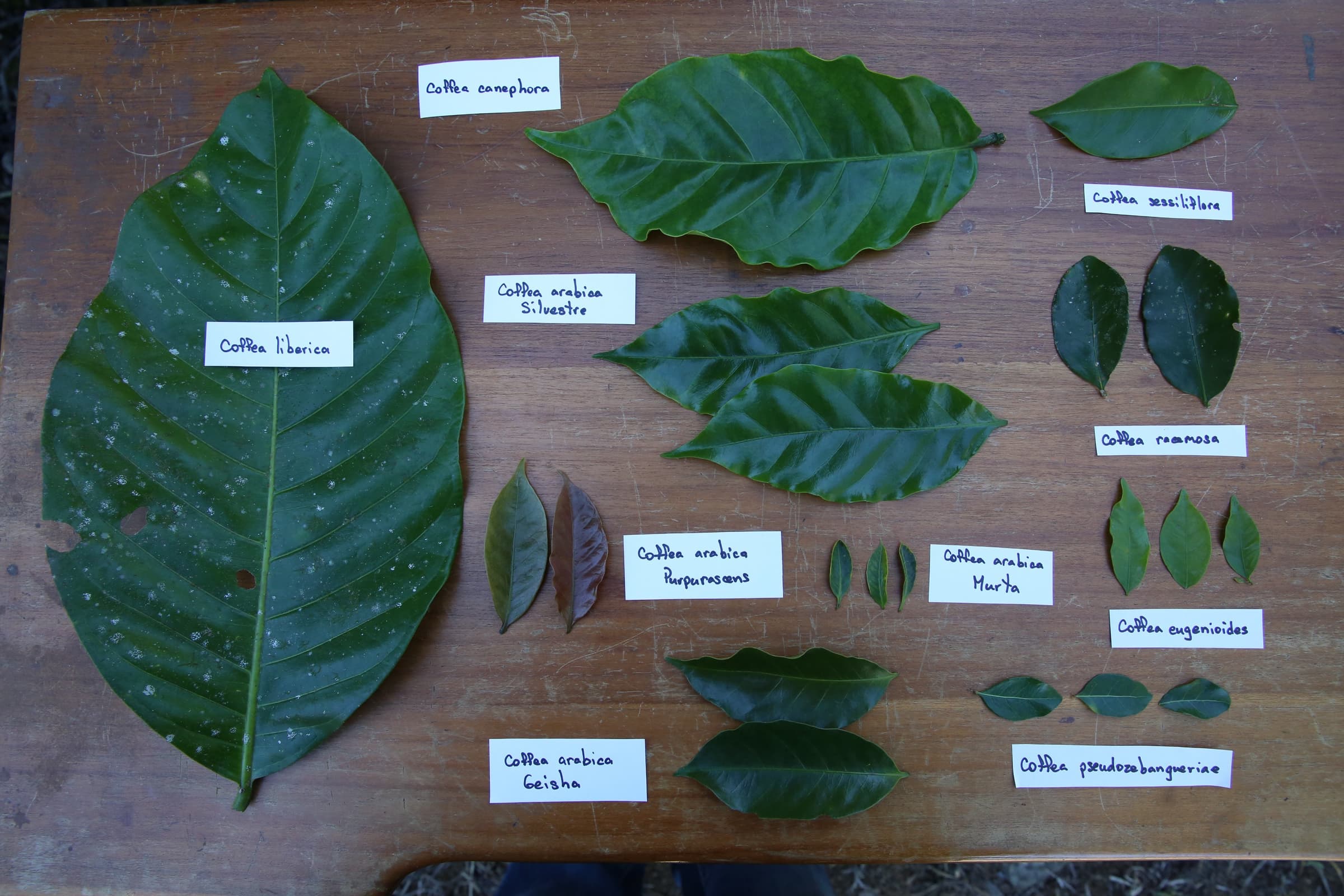Study: All Arabica derived from a single ancestral plant
Has lower genetic diversity than any other major crop species in the world

Photo credit: LM Salazar, Crop Trust / #CropsInColor
A new study published today used modern genetics tools to trace the history of the Coffea arabica species, the most common and economically important commercial coffee crop species worldwide. Researchers confirmed the significantly likelihood that C. arabica derived from a single speciation event, a spontaneous coupling of individuals of two different species—Coffea canephora and Coffea eugenioides—that brought together the two genomes to create a new species. All C. arabica grown around the world today therefore originated from a single plant an estimated 10,000 to 20,000 years ago. "This means that a single plant, a super-individual, has given birth to the whole C. Arabica species and to the millions of trees that are cultivated today all over the world in the intertropical belt,” says co-author and coffee breeder Benoit Bertrand of CIRAD.
The very recent birth of the C. arabica species and the extreme form of genetic bottleneck resulting from this singular speciation event supports the researchers’ other main finding: That C. arabica has lower genetic diversity that any other major crop species in the world. "Researchers have known for a long time that the genetic diversity of Arabica coffee is low,” says WCR CEO Dr. Jennifer “Vern” Long. “This paper provides clear, definitive evidence that the diversity is even lower than we thought. This is tremendously concerning for a crop as important as coffee. It reveals a profound vulnerability for any business that depends on coffee. At the same time, the paper points to key pathways for reducing that vulnerability through the breeding of F1 hybrid Arabica varieties that utilize Arabica's existing but underexploited genetic diversity, as well as for breeding with other species in the coffee family. Both activities are urgent. The good news is that both are underway."
The study was published today in Nature Scientific Reports; the research was led by World Coffee Research, Istituto di Genomica Applicata (Italy), and CIRAD (France), in collaboration with the Italian Universities of Trieste, Udine, Padova and Verona and with key contributions from CATIE, the University of Sana’a in Yemen, Texas A&M University. The paper’s first co-authors are IGA Technology Services’ agrigenomics lead Simone Scalabrin and WCR’s molecular breeder Lucile Toniutti. The study was funded by leading Italian coffee companies illycaffè and Lavazza for the purpose of enhancing scientific knowledge to ensure the future of coffee agriculture.
The results have important implications for the future of coffee breeding programs worldwide, which typically seek to exploit genetic diversity to help farmers meet challenges ranging from a changing climate to diseases and pests. Many of the approaches used by breeders in other crops will not work for Arabica, given its dramatically low diversity. The findings suggest that long-term, breeders will need to look to related species in the Coffea family to find adequate genetic diversity to meet the challenges ahead—especially climate change—and to use modern breeding approaches to introduce novel diversity. Despite this, the authors also suggest that there is untapped diversity for breeders to take advantage of “hybrid vigor” by crossing Arabicas from divergent genetic groups to create new F1 hybrid varieties.
Using genetics to trace the history of Arabica
Despite the authors’ robust findings about the low diversity of Arabica, they were able to discern three distinct genetic groups, which add significant empirical support to historic accounts of coffee’s movement out of Ethiopia. C. arabica originated in the wild upland forests of Ethiopia; historical accounts tell us that coffee moved to Yemen in the 14th century, where it was first used for cultivation in full-sun growing systems. From Yemen, two many groups of coffee, the Bourbon and Typica lineages, moved to the rest of the world, where they continue to dominate production. Previous studies of Arabica distinguished only two groups: A group containing the commercial varieties that moved from Ethiopia to Yemen and then on to the world, as well as a group of “wild” Ethiopian Arabicas. In this study, the authors revealed three distinct groups:
- A confirmed “Yemen-Harare” group, which contains the vast majority of all varieties cultivated globally, as well as varieties domesticated in Yemen, which seem to be adapted to full sun
- A group of Ethiopian wild and garden coffees originating from the Jimma-Bonga region, in the southwest of the country
- A separate Ethiopian group largely from wild forests, still very little known, originating around Sheka in the southwest of the country
The authors also consider that there may be a fourth group based around the Harenna forest on the eastern edge of the Rift Valley, but that there were not enough individuals from Harenna in the sampled populations to test this.
Implications for future breeding
Most of the coffees from the Jimma-Bonga and Sheka groups have never been used in coffee breeding programs outside Ethiopia. The existence of these groups, and their distinctness from commercial varieties, mean that it is possible for breeders to utilize them to make F1 hybrid crosses that bring new and desperately important genetic diversity into cultivated varieties. Because such F1 hybrids capture this additional genetic diversity, they are typically better adapted to a wide range of environments than traditional varieties, which is crucial for supporting short-term adaptation to climate change.

One of WCR's experimental F1 hybrid crosses being harvested in November 2019.
Indeed, this work is already underway. A consortium of breeders from CIRAD and Promecafe, released the first wave of F1 hybrid varieties starting in 1997 (created by crossing commercial varieties with “wild” types from the CATIE germplasm collection); a second wave from CIRAD and ECOM was released in 2010.
Given the success of these first waves of F1 hybrids, WCR believes they will be very important to the success of farmers and the future of coffee. World Coffee Research is currently evaluating additional F1 hybrid crosses in field trials in four countries.
At the same time, the results of the study add significant empirical support to long-time observations about the low genetic diversity of Arabica that make the species extremely vulnerable in the long term. To deal with the low diversity, breeders will likely need to turn to other coffee species or coffee species introgressions such as the famous Timor hybrid derivatives to enlarge the “genetic toolkit” available for coffee to withstand pests, diseases, rising temperatures, and other threats.
"The compelling conclusions of this paper support WCR's short and mid-term breeding strategies,” says WCR molecular breeder Dr. Lucile Toniutti. “In the short term, despite extremely low Arabica genetic diversity, significant hybrid vigor still exists when crossing divergent Arabicas (wild x cultivated) to create F1 hybrid varieties—meaning genetic diversity is adequate for progress using F1 hybrids. IN the medium and long term, our strategy is to pursue the intgrogression of traits from C. canephora into Arabica; that work has begun."
An international team of collaborators, a genome sequence, and a ton of coffee
The study brought together researchers from around the world in public-private collaboration to decode the “genetic history” of Arabica. The findings relied on two key elements: the completion of a genome sequence for Arabica, and the genetic characterization of hundreds of genetically diverse Arabicas.
The completion of a publicly available genome of C. arabica (available here), was released publicly last year by an Italian research partnership, led by researchers from Istituto di Genomica Applicata, Lavazza, illycaffè,, and Italian universities. The genome sequence was completed on a Red Bourbon individual; researchers estimated a ~1.3 Gbp genome size. From the publicly available germplasm collection of CATIE in Costa Rica, researchers analyzed genotype-by-sequencing (GBS) data for 736 Arabicas, as well as a collection of 93 Arabicas from Yemen, the domestication origin of Arabica. The study is the first to use a GBS approach to study the genetic diversity of a C. arabica collection and relatedness to the carefully disentangled parent species, C. canephora and C. eugeniodes, allowing the authors to confirm the geographic structure of Arabica genetic diversity.
The co-lead authors of the study were Lucile Toniutti, molecular breeder for WCR, and Simone Scalabrin of IGA Technology Services (a service company owned by Istituto di Genomica Applicata, the DNA sequencing center that led the Arabica genome project). Major contributions to the study were made by the Italian research partnership sequenced the Arabica genome used in the research (including researchers from Lavazza, illycaffè,, the Istituto di Genomica Applicata, University of Udine, Padova, Verona and Triest, the Institute of Biosciences and Bioresources), with major contributions from researchers at Texas A&M University, CIRAD, CATIE, and the University of Sana'a in Yemen. Additional major contributions to the study were provided by researchers at Texas A&M University and CIRAD.

Lucile Toniutti, WCR's molecular breeder